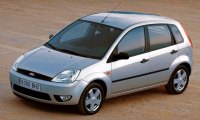 The
old Fiesta always caught the heart of British media by its first-class
handling. Autocar even gave it 4 stars out of the maximum 5. In
contrast,
AutoZine rated it just 2-star. Why ? because without an acceptable
level
of cabin space and build quality a mini hatch will never succeed no
matter
how nice it goes. The
old Fiesta always caught the heart of British media by its first-class
handling. Autocar even gave it 4 stars out of the maximum 5. In
contrast,
AutoZine rated it just 2-star. Why ? because without an acceptable
level
of cabin space and build quality a mini hatch will never succeed no
matter
how nice it goes.
Ford also knew this. Therefore when it developed the new generation Fiesta it put space and quality into the top priority list. The new Fiesta is a lot larger. However, instead of comparing with its predecessor whose origin can be traced back to 1989, we simply take the latest Volkswagen Polo for reference. The Fiesta is 26mm longer and 33mm wider. Wheelbase is 26mm longer too. Only the height is shorter. As a result, the cabin becomes one of the largest in the class, matching Polo, Fiat Punto and Skoda Fabia while beating Toyota Yaris and Peugeot 206. Unlike the Volkswagen duo, it gains extra space without adding too much weight. For instance, a fully-equipped 1.4-litre Fiesta Ghia weighs 1000kg, some 100kg lighter than an equivalent Polo. Ford’s Zetec-series engines are not very powerful - 80hp for 1.4-litre and 101hp for 1.6-litre, so performance is just average. However, they have lightweight aluminium blocks to relieve the load at front wheels. Best of all, they operate smoothly and eagerly at all rev. Not particularly quiet at high rev, but the noise is pleasing. Refinement is also high in the chassis and suspension department. The stiff bodyshell is attached to front MacPherson struts via an NVH-reducing subframe. Springing is firmer than most rivals but damping is superb. The Fiesta has the ride quality and composed handling of big cars, but with more driver appeal than the softly-sprung Polo.
The steering is also a let down. Previous Fiesta provided uncorrupted and sharp steering feel. The new one is not very communicative although it is kickback-free. Feel has been given way to refinement. I am not sure whether it is the best handling supermini today. Toyota Yaris steers more eagerly and agilely, but the Fiesta is more stable and composed in twisty roads and on rough surfaces. However, its ride quality is definitely more polished. 4 six-footers can sit comfortably in the Fiesta, with plenty of leg and headroom. Build quality of cabin is very satisfying, especially the solidity of dashboard. It employs high-quality plastics just overshadowed by Volkswagen. Get out of the
car, look
at its exterior shape once more and you may notice it is more like a
Volkswagen
than Ford. Admittedly, you don’t know what a Ford is supposed to look
like.
If you judge it by the standard of Focus, you will be disappointed by
its
conservative styling. Mini car could be funny to look at, but not this
one. It incorporates the nose of Focus into a conventional body with
Punto-style
rearlights. Not very imaginative. Just like the ingredients of the car,
it satisfy most people but simultaneously lacks character.
|
| The above report was last updated on 20 Jan 2002. All Rights Reserved. |
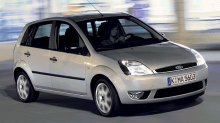 However,
it is not a mini Focus yet. Remember, the Focus has an unique "control
blade" independent rear suspension. The Fiesta uses the same torsion
beam
axle like most rivals in order to squeeze out more cabin and luggage
space.
Therefore, while it is tuned to deliver a safe-understeering feel that
most customers want, it is not versatile enough to satisfy keen
drivers.
However,
it is not a mini Focus yet. Remember, the Focus has an unique "control
blade" independent rear suspension. The Fiesta uses the same torsion
beam
axle like most rivals in order to squeeze out more cabin and luggage
space.
Therefore, while it is tuned to deliver a safe-understeering feel that
most customers want, it is not versatile enough to satisfy keen
drivers. 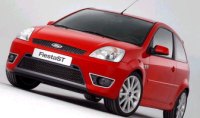 Feeling
jealous for the success of Renault Sport Clio, Ford also produced a hot
Fiesta. Unfortunately, while the Clio has a 182hp engine pushing barely
1090kg of weight, the Fiesta ST has its 150hp engine struggling to cope
with 1137kg. As a result, instead of "hot hatch", it is barely
lukewarm.
It takes 7.9 seconds to accelerate from 0 to 60mph. For comparison, the
Clio takes 6.3 seconds. They are clearly not in the same league.
Feeling
jealous for the success of Renault Sport Clio, Ford also produced a hot
Fiesta. Unfortunately, while the Clio has a 182hp engine pushing barely
1090kg of weight, the Fiesta ST has its 150hp engine struggling to cope
with 1137kg. As a result, instead of "hot hatch", it is barely
lukewarm.
It takes 7.9 seconds to accelerate from 0 to 60mph. For comparison, the
Clio takes 6.3 seconds. They are clearly not in the same league.
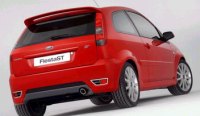 Fiesta
is always strong at body control and damping. The ST's tuned
suspensions,
revised steering geometry, larger wheels, tires and brakes sharpen
handling
further, with little side effect in ride quality. But as before, it is
not particularly inspiring to drive and to push to the limits.
Artificial
steering feel, lack of throttle steer and a not-so-slick gearchange
work
against driving fun.
Fiesta
is always strong at body control and damping. The ST's tuned
suspensions,
revised steering geometry, larger wheels, tires and brakes sharpen
handling
further, with little side effect in ride quality. But as before, it is
not particularly inspiring to drive and to push to the limits.
Artificial
steering feel, lack of throttle steer and a not-so-slick gearchange
work
against driving fun. 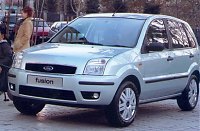 Ford
design chief, J. Mays, is enthusiastic about his brainchild Fusion and
described its as a new kind of vehicle - UAV, or Urban Activity
Vehicle.
This sounds stupid to me. What activities do we do with a car in urban
area? most likely the same as we do with the regular Fiesta! in fact,
UAV
just implies that the Fusion is no more than a SUV lookalike without
any
off-road ability and MPV versatility. It just fools its buyers by a
taller
body, larger ground clearance, higher driving position, muscular
bumpers
and wheelarches. In Mays’ words, "you get the safe feeling as in a
sport
utility". Just feeling.
Ford
design chief, J. Mays, is enthusiastic about his brainchild Fusion and
described its as a new kind of vehicle - UAV, or Urban Activity
Vehicle.
This sounds stupid to me. What activities do we do with a car in urban
area? most likely the same as we do with the regular Fiesta! in fact,
UAV
just implies that the Fusion is no more than a SUV lookalike without
any
off-road ability and MPV versatility. It just fools its buyers by a
taller
body, larger ground clearance, higher driving position, muscular
bumpers
and wheelarches. In Mays’ words, "you get the safe feeling as in a
sport
utility". Just feeling.